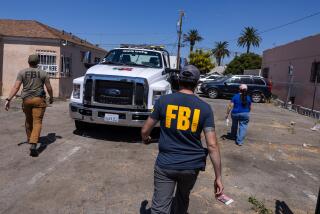Police to Focus on Career Criminals
- Share via
Confronted with the first significant crime increase in a decade, Santa Ana police Tuesday announced a campaign against career criminals, including the formation of a team that will develop profiles and gather intelligence on hundreds of suspected robbers and thieves.
The team will take a fresh look at 10 years’ worth of investigative files to determine whether suspects in previous crime sprees are again operating in the city. They will also use computer mapping and other software to seek links among cases and uncover patterns.
“We want to focus our efforts on identifying that percentage of the population that constantly commits crimes over and over again,” said Santa Ana Police Sgt. Ed DeMarco, who oversees the new unit. “A lot of these guys [are] contributing to the increase in crime.”
The effort comes as Santa Ana grapples with a spike in crime. The city, which during much of the 1990s garnered national attention for its plunging crime rate, experienced a 53% jump in auto thefts in the first six months of this year, a 16% rise in larceny and a 44% jump in homicides. Officials stressed that crime remains far below levels of just a few years ago. But they said even the modest jump concerns them.
The new campaign works on the assumption that the crime rise is caused by gang leaders and others who are now getting out of prison for arrests made in the 1990s.
Many top gang members were sentenced to prison after the city’s massive 1993 gang sweep known as Operation Roundup, which police have credited with reducing gang activity and crime. But in the last few years, many of the roughly 30 gang leaders have been paroled.
The unit has started out by reviewing 853 crime files involving suspects arrested 10 times or more in the last decade.
DeMarco described most Santa Ana career criminals as gang members who return to commit burglaries, robberies and drug sales after serving time behind bars. The department’s rule of thumb is that roughly 80% of these incidents are committed by about 20% of the criminal population, he said.
Using computer mapping and other databases to track crime patterns has its roots in New York City but has spread to police departments across the nation. Santa Ana is one of a growing number of cities to use the technology to also look at specific suspects and try to weed out career criminals.
Two years ago, Baltimore police used computer modeling in several troubled neighborhoods. Officials concluded that 15% of the suspects in those areas were responsible for 85% of the crimes. Baltimore is now planning to use the mapping database citywide.
Santa Ana, Orange County’s largest city, is paying for its program with $1.3 million in municipal funds and $200,000 in state grants.
The team consists of six officers and a sergeant. Data from suspects’ case files will be used to create the databases and maps.
By examining investigative files, officials hope to discover patterns in the way victims are targeted and gather insights into where certain criminals operate. Reviewing arrest records will also allow police officers to give special attention to suspects who are up against their third strike, officials said.
“We profile their criminal behavior,” said DeMarco. “We’re trying to stop them from ever getting out of jail again.”
Several crime experts have said Santa Ana’s rising crime rate is tied in part to the slowing economy.
Indeed, a lack of money has forced the city to reduce one of its gang suppression units. The unit once had 18 officers patrolling gang neighborhoods. Now only six officers are in the unit.
More to Read
Sign up for Essential California
The most important California stories and recommendations in your inbox every morning.
You may occasionally receive promotional content from the Los Angeles Times.










